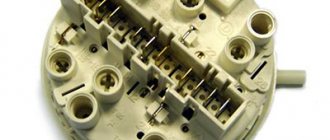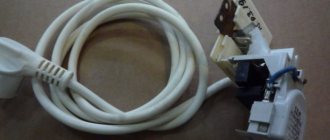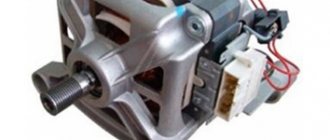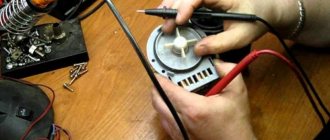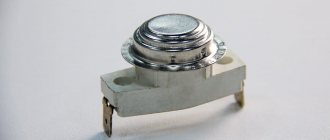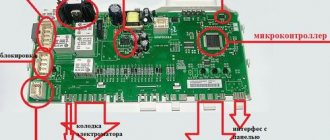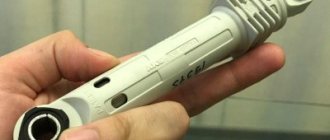The temperature sensor of the washing machine is the first link in the system responsible for achieving and fixing the heating level. Data from the electronic sensor is analyzed by a microcontroller, which turns the heating element on or off. If the thermostat is mechanical, then the detector is of the same type and acts directly on the relay. All problems with maintaining temperature can be associated with breakdowns of the temperature sensor. There are similar symptoms for malfunctions of the relay, thermostat, and electronics, so it is important to carry out the diagnosis correctly. Let's look at how to determine that the temperature sensor is broken, how to check it and replace it.
What is a temperature sensor, types
A thermal sensor is an element that determines the temperature in the measured environment and transmits the indicators to the control system, relay. In our case, it is also advisable to call the product in question a sensor-relay, a thermal relay, since the sensor of such a release is usually a difficult-to-separate part of it, it is a unit with a high degree of integrity, a module.
Mechanical types of heat detectors act on the relay directly, moving the contacts, closing or opening them. For any type of product, monitoring is carried out in real time, the element is always in working condition.
Thermal sensors of washing machines can be of 2 types:
- electronic (thermistors, thermistors, thermocouples). With two wires, terminals through which a weak voltage is supplied to the sensitive element. The thermistor changes resistance depending on heating/cooling. The data is received by the control electronics. The sensor has a microcontroller, which receives commands from the latter to close or open contacts depending on whether the temperature reaches or does not reach the user-set values;
- mechanical. This is a tube or segment with a temperature-sensitive substance, a material that, when heated/cooled, expands or contracts, respectively, pressing on the bellows with a rod in the thermostat or weakening the pressure by opening/closing the contacts.
Below we will consider the types of thermal sensors of washing machines more specifically. Similar elements are installed in all devices where they are required to be turned on/off. depending on the temperature achieved: for refrigerators, irons, convectors, and other heating equipment.
Bimetallic
Heat sensors with a bimetallic part belong to the mechanical variety of such meters. The sensitive segment is a plate made of two layers or strips of different metals. When heated/cooled, the segments do not expand/contract equally because they have different coefficients of response to temperature.
The plate connected to the contacts bends and moves them accordingly - closing or opening them. The force can be transmitted through a ceramic rod that performs the specified movement.
This type of sensor is largely an element inseparable from the relay. A thermostat with such a sensor is considered as a single unit; its part in the form of the described sensor is almost never changed separately. That is, it is difficult to separate the sensitive element from the relay and install a new one. This replacement segment is difficult to find on sale; you can only take it from used devices.
Another obstacle to replacing only the sensor part: usually thermostat models with such components by design do not provide for the possibility of dismantling it. The segment is soldered or inserted in such a way that when removed, the seat will be damaged. However, theoretically it is possible to replace it, but they don’t do it also because it creates a high probability of miscalibration. Usually they buy a whole relay.
A bimetallic detector breaks down extremely rarely, less often than all other options - due to its simplicity and solid design, there is nothing special about it that fails even from wear and tear over time. It is not afraid of an aggressive environment, voltage or temperature changes. In fact, the entire assembly is two strong, durable plates that move the same terminals. The only possible possibility is oxidation and sticking of the contacts inside. The advantage of such products: almost eternal performance, low cost. Cons: small measurement range, inaccuracy, slow response.
Gas-filled
The second type of mechanical temperature sensors in washing machines are gas-filled (capillary) sensors. This is a sealed tablet, a thickening, a flask on the same tube that goes into the thermostat. The listed elements are hollow, inside there is a substance that reacts to heat and cold, usually freon, maybe an arc-like gas.
The end that goes into the thermostat is equipped with a bellows - a part resembling a metal accordion, which provides a more stable (fixed) tension and compression than a spring.
The principle of operation is this: when the temperature changes, the state of the substance inside the tablet and tube changes, pressure arises, moving its end with the bellows, which in turn moves the rod, which affects the contacts, closing/opening them.
The level of inseparability of such a sensor from the relay and the impracticality of repair are similar to those described above. The gas-filled sensor is also very durable due to the simplicity of the design and its mechanical type. Typical failures: souring, sticking of contacts inside the relay, depressurization of the tube with the bulb.
NTC: thermistor, thermocouple
Thermistor (thermal resistor) and thermocouple are resistance sensors (NTC type - Negative Temperature Coefficient). Technically these are different elements. But we will use these 2 names or generalized terms - electronic sensor or with a microcontroller, since the aspect under consideration is similar. Thermistors are used in washing machines; they provide more accurate measurements.
Operating principle: a small voltage is applied to the sensitive element (thermistor, thermocouple). Depending on the temperature, the material of these elements changes resistance, which is analyzed by the microcontroller (relay) and, depending on the values of the heating settings set by the user, closes or opens the contacts of the heating element.
The electronic sensor consists of segments:
- the sensitive part is enclosed in a small housing, about 10 mm in length and several mm in width. This, strictly speaking, is the main functional part, the sensor tip, the thermistor itself, the thermocouple;
- a cable with two wires with a plastic plug that connects to the connector of the control unit, the electronic board of the washing machine. In this part there is also a microrelay that moves the contacts. More often, such a sensor does not have a cable between the chip and the thermistor - the terminals and relays in the plastic key are immediately connected to the sensitive part.
The two previous types of mechanical sensors are installed in washing machines with controls and thermostats of the same type. This is not to say that such products are not effective; their advantage is an increased service life, they are less likely to break down, since there are fewer electronic parts. Disadvantage: fewer “smart” and advanced features, small adjustment range. For mechanical control, characteristic selectors are in the form of knobs, and there are no touch screens.
Thermistor detectors are installed in washing machines with electronic controls. They break down more often, but are cheap, and make it possible to install a control system with more advanced options, with an expanded range of adjustments, and programmability. Such devices may have a selector knob (it is not completely mechanical, but connected to electronics), but a more typical touch screen, LCD display.
Advantages of a temperature sensor with a microcontroller, including maintainability:
- the most accurate of all possible options;
- If it fails, it is enough to change the part with the sensitive element, wiring and chip. If the model has a cable and it is intact, then you can cut off and solder only a new tip;
- ease of dismantling/installation: just unclip the wiring from the chip (block) and remove the element from the seat on the outer plate of the heating element. The overall thermostat housing, like a mechanical one, does not need to be removed from the control unit;
- cheap: you only need to buy a segment with a plug and a thermistor (thermocouple) - it has everything, including a relay. This small device costs much less than mechanical types of sensors.
Cons: electronic sensors break down more often and are more susceptible to failure due to power surges or aggressive environmental influences. This disadvantage is relative - to summarize, the service life of such sensors is shorter, but not too different from mechanical options, which is also affected by the lack of moving parts.
Purpose and types of temperature sensors
The task of this element of the washing machine circuit is to control the temperature of the water in the tank. The sensor measures parameters in real time, transmits information to the control module, which in turn analyzes the data and, if necessary, gives the command to turn on the heating element.
Modern washing machines can be equipped with three types of sensors. Each of them has its own characteristics, advantages and disadvantages. These are: a bimetallic element, a gas-filled temperature sensor and an electronic thermistor sensor.
Bimetallic element
This is a purely mechanical device. The moving element of the sensor is a plate made of two metals, one of which has a significantly higher coefficient of thermal expansion. When the set temperature is reached, the plate bends and closes or opens the contacts.
Exactly the same element is used in irons, cheap convectors and other heating equipment with a temperature measurement function. The sensor is simple and fairly reliable, but has low accuracy and often fails due to oxidation of the contacts.
Gas-filled sensor
A temperature sensor of this type consists of a sensor itself with a sealed tube filled with gas, a temperature controller and a conductor that connects them. The sensor is installed in the tank; when the temperature changes, pressure arises, which acts on the membrane, closes and opens the contacts, turning the heating element on and off. Such temperature sensors are found in older Indesit washing machines.
This temperature sensor is distinguished by a fairly high accuracy of temperature measurement, but it is difficult to manufacture and prone to breakdowns. The slightest damage to the tube leads to a complete loss of functionality and the need to replace the sensor.
Thermistor
Unlike previous types, this is a completely electronic element. In modern washing machines, it has almost completely replaced mechanical parts. Found in almost all washing machines Samsung, Bosch and others. The temperature sensor is easy to change (it is installed directly next to the heating element). Structurally, it is a metal cylinder with a diameter of about 10 mm. There is a connection block for connecting to the wiring.
The operation of a temperature sensor is based on the effect of reducing its resistance when the ambient temperature changes. The absence of moving elements ensures a long service life, and electronic filling guarantees high accuracy of indicators.
Diagnostic features, symptoms of temperature sensor failures
The diagnostic problem is that the same symptoms as in the case of a faulty temperature sensor can be observed when the heating element (heating element) breaks down. Since the latter breaks down more often, it is worth checking it first - at least doing an external inspection, ringing its circuit with a tester.
The described disadvantage is eliminated if the washing machine is electronically controlled with a self-diagnosis function. In this case, the system will issue a sound, light or graphic signal (code). The decryption of the alarm message is in the instructions.
The remaining symptoms are as follows (especially relevant for a mechanical type of control without self-diagnosis):
- t° jumps, does not correspond to the set values. For example, with any program, mode, setting, the value rises almost to a boil. The body parts heat up and steam is observed near the loading hatch. This mode is especially dangerous - with constant overheating, the heating element will quickly fail;
- The heater does not turn on, the washing machine does not heat the water at all. That is, here the sensor has completely failed and does not provide any indicators.
To diagnose, you need to gain access to the sensor; let’s look at where it is located and what the dismantling process is.
The washing machine does not heat the water: external causes of the problem
Did you specifically choose a model with the “Eco bubble” function to better wash your clothes? If over time things get washed worse and worse, then you should pay attention to the operation of the heating system. First of all, check whether the programs actually run at low temperatures:
- Set the high temperature mode (“Cotton”, “Synthetics”).
- After fifteen minutes, try the sunroof glass.
Ideally it should be warm. If it is cold, then there is a problem. Don't worry, major repairs may not be required. Start with this check:
- Take a look at the control panel. Is the mode selected correctly? Perhaps the temperature was accidentally set to low? Then it is enough to change the settings to enjoy the effective operation of the washing machine.
- Double-check the connection of equipment to communications. The hoses must be positioned strictly according to the instructions, otherwise water may drain out. Due to constant circulation, the washing machine does not have time to heat the water.
Are external settings and connections normal? Then it's time to move on to the heavy artillery - checking the internal parts. We will tell you how to do this in the next paragraph.
Location of temperature sensors in the washing machine
The standard location for thermal mechanical detectors is near the heating element or drum, at the bottom of the housing, close to the motor, on a special plate with a hole-mounting area. The latter is a niche that goes into a tank of water so that it is possible to analyze the temperature of the liquid by almost touching it.
The electronic temperature sensor in the washing machine is located directly in the heating element, at its base, on the fixing plate. Outside, when the heater is mounted, its chip is visible, inside the tank - the thermistor itself in a small case.
Reasons for failure of temperature sensors
The main causes of thermostat failures are:
- Frequent washes at high temperatures. Such temperature conditions affect the rapid wear of many parts of washing machines, and also negatively affect the quality of the fabrics of the washed items. Modern detergents are quite effective in removing stains even at low washing temperatures;
- Unstable voltage in the power supply network. Voltage fluctuations have a detrimental effect on any electronic components, and short circuits instantly damage them. To use a washing machine, it is best to install a separate electrical wiring line from the meter of your home.
- The wires must have a sufficient cross-section to avoid overheating of the insulation. The device must be grounded. For your own safety, you need to install an RCD (residual current device).
The temperature sensor is one of the main and important elements of the washing machine - it is responsible for heating the water to the required temperature, and then the temperature sensor turns off.
If you notice that your washing machine “overheats” the water very much or, on the contrary, does not heat it at all, then the problem lies precisely in the temperature sensor. In our article you will learn how to check the temperature sensor for its functionality and for replacement (if required).
How to remove the electronic temperature sensor in a washing machine
To see the detector, you need to remove the back panel of the washing machine. Of course, before the procedure, the power plug of the device is pulled out of the socket.
The procedure for partially disassembling the washing machine to gain access to the temperature sensor:
- Disconnect all hoses (inlet, outlet).
- Unscrew the screws of the back panel and remove it.
- Loosen the screw fixing the heating element, remove the temperature sensor, unclip the power wires from the sensor connector.
Functionality check
To check the temperature sensor, you must provide access to it. To do this, turn off the power to the washer and turn off the water supply. Next, you will have to dismantle the outer panel and some internal parts. The easiest way is to remove the thermistor from the system, since it is located directly in the heating element. In popular models such as Indesit and Samsung, the temperature sensor is installed at the bottom of the system.
To dismantle the thermistor you will need:
- remove the rear panel of the machine;
- disconnect the temperature sensor from the wires;
- loosen the heating element;
- remove the thermistor from the system.
After removing the sensor, you will need a multimeter to measure the resistance. This is done this way:
- Set up your multimeter and get ready to test the resistance.
- Connect the probes of the device to the contacts of the temperature sensor. Remember that when the temperature reaches twenty degrees, the resistance should not exceed 6000 Ohms.
- Place the temperature sensor in the water and carefully monitor the multimeter readings. If the sensor is working properly, its resistance will begin to decrease. In water at a temperature of thirty-five degrees it will reach 1350 Ohms.
Important! If you find that the sensor is damaged, immediately replace it with a new one. This part cannot be repaired, and if faulty it can lead to breakdowns.
How to diagnose an electronic temperature sensor (NTC)
The electronic sensor (NTC) changes its resistance as the temperature rises or rises. This is the basis for how to check the temperature sensor of a washing machine of this type. It is this particular feature of the operating principle that gives a 100% analysis result and makes the procedure simple.
You will need a multimeter; it is switched to resistance measurement mode; you can also use an ohmmeter. Next, the detector values are analyzed when exposed to different temperatures.
It is advisable to clarify the test results: compare the resistance of the temperature sensor, the temperature sensor of the washing machine with the table from the specification for a specific sensor model (data can be found on the manufacturers’ websites).
For example, we learn the relationship between the resistance of a thermal sensor and the temperature on an LG washing machine from the specification table for a specific detector with a certain marking:
Algorithm:
- We disconnect the chip and remove the sensor from the socket.
- We switch the multimeter to resistor testing mode, that is, to measure resistance - select 200 kOhm.
- We attach probes to the sensor contacts and look at the result. The normal value at room temperature (+25° C) is about 6 kOhm. The indicated figure is the standard for most products. It is possible that there may be other parameters, so we recommend checking the technical documentation for the washing machine and the specifications of the detector.
- They lower the thermistor into warm water, take repeated measurements, add boiling water and watch how the indicators change. At approximately +50°C the tester should show about 1.5 kOhm. If the value does not change (and it should do this as the liquid cools), then the sensor is broken.
You don’t have to remove the sensor and pour water into the same tank of the washing machine. The principle of such a check is similar to the same procedure for refrigerator sensors, as well as for most household appliances.
Checking the temperature sensor for functionality and further replacement
The first step is to de-energize the washing structure . Then the car needs to be disassembled. The easiest option is to remove the thermistor from the washing machine, which is located inside the heating element. In most of the different models of washing machines from different manufacturing companies, the heating element is located in their lower (base) part.
We remove the thermistor in four steps:
- Remove the back panel of the washing machine;
- Disconnect the wires from the sensor that are directed to the temperature regulator (external);
- Slightly loosen the screw that holds the heating element;
- Remove the thermistor from the device.
Here is the thermistor in our hands. To check it, you will need a multimeter with which we can measure the resistance. Let's go through everything step by step:
- First you need to set the multimeter to measure resistance;
- Now you need to connect the wiring to the contacts of this sensor. ( Reference: 20 degrees is about 6000 Ohm, or 6kOhm);
- We check the functionality: to do this, lower the sensor into hot water, while looking at the results of the multimeter. The sensor is operational when the resistance is lower. For example, if the temperature is 50 degrees, then the resistance value should be approximately 1350 Ohms.
If the temperature sensor does not work, then it needs to be replaced, since it can no longer be repaired. Reassemble the structure in the same order as you disassembled it.
In order to get to the gas-filled temperature sensor, you need to open not only the back panel, but also the front cover (where the control panel is located).
This is necessary in order to disconnect the sensor (or rather its outer part) from the panel itself. Once you have disconnected the external sensor, you need to go back to the back cover, remove it and locate the wiring on the tank body. Carefully pull off the rubber insulation so as not to damage the copper tube. This can be done with a thin awl or a needle. Carefully reach under the skin of the elastic and make a couple of circles - this will make the insulation easier to pull together. A little effort while lightly pressing on the sensor (push on the base, moving the sensor a little deeper) and it will jump out of the groove. After this action, you can safely pull out the temperature sensor through the tank (or rather, the hole located in it). Then everything is simple - disconnect the wires and check it with a multimeter. As a result, the sensor becomes impossible to operate. Replacement is carried out as follows. First, buy a new sensor (preferably a kit that also includes a switch) and install it in place of the old one, then assemble everything in the same order.
The bimetallic temperature sensor is also difficult to access; you also need to get to it through the tank. Then disconnect the wires from the thermostat.
Then we connect the contacts to a multimeter and look at the resistance result. Heat the water to a hot temperature and lower the sensor into it - this action is necessary in order to check changes in resistance. If the resistance readings have dropped sharply, it means the temperature sensor is working, but if not, then it needs to be replaced.
Basically, bimetallic sensors break due to a worn plate. In this case, replacing the sensor is very simple; buy a new thermostat (the same one) and install it in place of the old one.
Signs of a temperature sensor failure: main failures
Here are a few main signs.
- With different washing modes and a certain temperature chosen by you, the heating element brings the water in the washing machine to a boil ;
- During the washing process, the body of the machine becomes very hot , and steam comes out of the loading hatch door.
If your washing machine has such a problem, then you need to get rid of it immediately. Otherwise, it may cause your heating element to burn out. And do not forget that replacing a heating element is several times more expensive than replacing a temperature sensor.
Replacing the temperature sensor in a washing machine is a fairly easy and simple task that absolutely anyone can handle. You just need to buy exactly the same temperature sensor and install it in place of the old one. We wish you good luck!
Thermal sensor is an internal element of the washing machine that is responsible for heating the water to a certain temperature and turning off the heating element. And if at one point the machine heats the water too much or doesn’t do it at all, then the cause of the breakdown may be the temperature sensor. We will talk further about how to check its functionality and, if necessary, replace it.
Analysis of the health of the gas-filled temperature sensor of the washing machine
A sensitive thermoelement filled with gas is often found in Indesit or LG brands, in older models, as well as in inexpensive products, including domestic ones. The working segment of such a sensor is a sealed tube with gas (usually filled with refrigerants, since they are very sensitive to heat), at the end there may be a flask or a tablet-shaped extension.
You need to unscrew the bolts of the back panel and carefully pull it out. In addition to self-tapping screws, the plate can also be fastened with clamps or latches; in this case, movements must be especially careful so as not to break the plastic parts. We will not describe the exact placement of the mount, since it may be different for each model. To get acquainted with such information, you need to look at the instructions or forums; there may also be a diagram or disassembly instructions.
After locating the sensor with the relay (at the bottom back near the tank and drum), you need to press this unit inward with reasonable force and pull it out through the tank. Next, disconnect the wiring and carry out a test.
So, the sensor is removed with the thermostat. This type is a solid unit, like a bimetallic one, so there is no need to try to separate the part with only the sensor, it is difficult to do, and besides, the device cannot be checked in this form - the entire assembly must be analyzed.
Examination:
- The selector is set to +45…+50° C.
- Take any container and pour water at the specified temperature into it.
- A detector (tube) is lowered into the vessel.
- They will check when the trigger occurs, the contacts close - it should happen when the temperature drops below the set value.
If the response is not observed or is incorrect, then the sensor is broken. If the sensor is working, but the device still does not turn on, then most likely the thermostat circuit is faulty (open, shorted). This part is also checked with a tetser (continuity test).
It is only the element in the form of a tube with a bellows that is rarely changed - they buy the entire thermostat with it. On sale, individual such units are very rare; more often they can be bought from disassembled used relays in workshops, or via the Internet from individuals. If you want to carry out such a procedure, you need to bend the tabs or unscrew the bolts at the end of the thermostat, remove the end of the tube with the bellows, and insert a new part in the same way. But usually this is never done because it is inexpedient; with such a replacement, miscalibration is often observed.
What is the resistance of the washing machine temperature sensor?
Depending on the specific model of the machine and the type of sensor used, the resistance will vary. For Zanussi, Electrolux, AEG models at a temperature of 30°C the indicators will be 17-17.5 kOhm, and at 80°C - about 2.1-2.5 kOhm. Typically, the higher the temperature, the lower the resistance.
For Candy models in normal modes, the indicators are 27.0 kOhm. Ardo machines have about 5.8 kOhm. Ariston has 20.0 kOhm. The resistance of Samsung sensors at room temperature is 12 kOhm.
However, such information is not 100% genuine and therefore cannot be used as a basis for immediate repairs. It is necessary to accurately establish the specifications for a particular model and only then carry out replacement or attempt to troubleshoot. Details can be found in the machine descriptions or on the website of the household appliance manufacturer.
If you take on repairing a washing machine, you will need to carefully check everything and prepare the tools. However, it is always better to consult with experts about your specific model.
See also:
Checking bimetallic thermal sensors
Extremely durable and reliable bimetallic sensors, despite some disadvantages (accuracy, range and speed are somewhat lower), are found quite often on inexpensive washing machines.
Bimetallic temperature detectors are removed and diagnosed in the same way as gas detectors. Set a certain value on the selector, place it in a container with warm water at a temperature equal to it, and see if it triggers.
There is also a standard way to check the temperature sensor of a washing machine with a multimeter - continuity. When the contacts are connected, the tester shows different digital values, usually close to zero (0.01 and so on), that is, the absence of a break, and when disconnected, the break value will be “1” on the display.
Variety of temperature sensors
An automatic washing design can be equipped with only one of the following three temperature sensors :
- Bimetallic;
- Thermistor;
- Gas-filled.
The bimetallic temperature sensor looks like a tablet, approximately 20-30 millimeters in diameter and 10 millimeters in height. Inside this small tablet is a bimetallic strip. During the process of heating water, when it reaches a certain temperature, the plate bends and creates a closure of the contacts. Under this condition, the heating process is completed.
The thermistor has become a fairly popular element among modern washing designs, which has replaced the temperature sensor.
The thermistor looks like a small elongated cylinder. Its diameter is about 10 millimeters, and its length reaches about 30 millimeters. This cylinder is attached directly to the heating element. The principle of operation of such an element does not involve any mechanical work of the part, but simply changes the resistance during the process of heating the water to the temperature you need.
Replacement and repair of temperature sensors in washing machines
The temperature sensor for a washing machine cannot be repaired; there is only one way out - buying a new product. Thermistors and thermocouples cannot be disassembled for obvious reasons. The same applies to the bellows tube; when it depressurizes, gas escapes from it. It is impossible to fill the flask and immediately seal it at home, because the substance evaporates. But still, if we assume that this was successful, then even the most reliable sealing of a hole with solder will not be durable in an aggressive environment and constant changes in pressure.
It can be repaired only if the breakdown concerns loose, stuck contacts. The mechanical sensor can be disassembled and inspected inside the terminals, cleaned of dirt. For electronic detectors, you can change the cable, as well as remove oxidation from the metal parts of the block and mating connector, just remove/insert it several times.
Installing a new sensor is a procedure similar to the dismantling we described, only with the appropriate order. For mechanical sensors: the end of the tube is placed, the sensitive element is in the measured area, then the selector with a thermostat is secured; if the sensor is electronic, its block is snapped in place and the contacts are fixed. The last stage is to assemble the panels.
In the case of an electronic detector of standard size with a cable, if there is a similar sensitive element, but without a block with wiring, then the old tip of the sensor can be cut off and a new part can be soldered to the wiring.
Gas-filled and bimetallic thermostats
The gas-filled thermostat consists of two parts:
- metal washer (tablets),
- copper tube.
The sensor is filled with freon. This gas changes its state when the water temperature changes, causing the contacts going to the heating element to close or open.
The washer is located in the washing machine tub, the copper tube is attached to the control panel.
A bimetallic thermostat also resembles a tablet, but works by changing the position of a special plate. When the plate bends, the contacts close.
The gas-filled thermostat is the only temperature sensor that can be repaired (the rest cannot be repaired, only replaced with new ones).
, the copper tube is usually . The gas evaporates, escaping through small holes and cracks. If the damage to the tube is minor, the tightness is restored, and the tube itself is filled with freon again.
They check such a thermostat by filling it with freon and observing whether it comes out of the tube. Such a check is carried out by a professional master.
The bimetallic temperature sensor fails due to wear of the plate over time. This thermostat is checked in test mode.
First, a special device (multimeter) measures its resistance at room temperature, and then in a heated state (the device is first lowered into hot water).
If in the first and second cases the multimeter shows approximately the same values, the bimetallic temperature sensor is faulty. A working sensor in a heated state has much lower resistance.
The non-working bimetallic temperature sensor is replaced with a new one.
To remove the thermostat from the washing machine, you will need to partially disassemble it (remove the back cover and front panel) and remove the sensor through the hole in the tank (pull off the insulation, sealing rubber and disconnect the wires).
After installing the new temperature sensor, the washing unit is assembled in the reverse order.
It is also better to entrust such repairs to a professional technician who has special knowledge, experience and tools.
Call a VseRemont24 service center specialist to your home at any time convenient for you! He will quickly and efficiently check, repair or replace any thermostat with a new one!
SMA INDESIT WD104TEX NTC resistance, tell me the resistance of the NTC thermistor
Please tell me the resistance of an NTC thermistor type ME0100 like this. It stands separately from the heating element. If possible, then the voltage at the sensor at 90 degrees. My native NTC is broken.
SMA Indesit W 43 s/n 310042248 p/n 46233110230, NTC resistance The heating element burned out, they brought a new one from the Tashkent service, but a Samsung one. When I started changing it, I rang.
CMA Indesit WT60 FR, Resistance of the NTC sensor Tell me, what resistance should the NTC sensor on the Indesit WT60 FR washing machine have? On the.
sma ARDO T80X NTC resistance sma ARDO T80X s.n. 2005280682501298003004 overheats. Replacing the KA engine and cleaning the switch.
Yes. Overheats. The water began to boil. The resistance of the original one is 2.2 kOhm, and the one in the heating element is 3.5 kOhm. As I understand it, at 90 degrees the voltage at the sensor is about 1 Volt. It is necessary to recalculate the divisor in the module. Either pick up the broken one or buy a new one.
Now I found a 12 kOhm sensor, it’s not clear where it comes from.
Yes. Overheats. The water began to boil. The resistance of the original one is 2.2 kOhm, and the one in the heating element is 3.5 kOhm. As I understand it, at 90 degrees the voltage at the sensor is about 1 Volt. It is necessary to recalculate the divisor in the module. Either pick up the broken one or buy a new one.
Now I found a 12 kOhm sensor, it’s not clear where it comes from.
I found a used one for 20 kOhm under the heating element. True, the connector is different. The machine periodically turned the programmer. I couldn’t catch it.
Yes. At 1.030 V the heating is turned off by 90 degrees. With that sensor, all the water would evaporate.
At night it’s difficult to find sensors that are lying around unnecessarily. I had nothing to do with them before. I thought they wouldn't break. In theory, you can push anyone there and recalculate the divisor in the block. The module is very strange in terms of connectors. Almost all are the same. I had to rack my brain before turning it on. So you need to mark without relying on keys.
skill. around and around.
I order tests, term papers, theses and dissertations here.
SMA Siemens WXLS160A/04 NTC resistance on 3ph module Hello. Maybe someone has such a module at hand, then I ask you to measure the resistance of the sensor.
SMA Zanussi FCS920C, p/n 914904000/00, temperature sensor, NTC resistance Hello! Please tell me which d.b. The resistance of the temperature sensor on this SMA is 4.8 or.
Repair of Haier HW60-B1286S AGR, NTC resistance of Haier HW60-B1286S AGR reported fault does not heat the water. According to the owner, he washed his underwear.
SMA gorenje WA61061R resistance thermistor Hello! gorenje WA61061R resistance of the thermistor on heating element 101Kom at 20 degrees Celsius.
Source
How to find the temperature sensor in an air conditioner
Indoor unit:
- Room air temperature sensor
This is the same sensor that sets the operating mode of the compressor.
- Evaporator temperature sensor (installed at the midpoint of the evaporator)
It serves to turn off the compressor when the evaporator temperature is below zero, or to indicate an error, in order to avoid icing of the evaporator.
- Temperature sensor at the evaporator outlet
- Fan motor temperature sensor
Shuts off the engine when overheated, preventing fire.
Overheating usually occurs in the event of an interturn short circuit.
- Thermal fuse in terminal block
- When the operating temperature is exceeded (most often about 90 0 C), it burns out, opening the air conditioner power circuit.
External unit:
- Outdoor temperature sensor
This sensor serves to limit the operation of the air conditioner when the outside temperature is below its operating range.
The air conditioner simply won't turn on if the outside temperature is below its limit.
- Condenser temperature sensor (several can be installed at different points)
The function of this sensor is to maintain the condensation pressure within a given limit when the outside temperature changes.
- Compressor discharge temperature sensor
The pressure can be indirectly determined by the discharge temperature, and if it is higher than normal, the air conditioner generates an error.
- Gas line temperature sensor
The gas line sensor duplicates the low pressure sensor, and generates an error when it decreases excessively.
- Temperature sensor on fan motor
- Thermal fuse on the connection block
There are also systems that determine the level of condensate using temperature sensors, instead of a mechanical float.
Thermal sensor repair service
Contact us and receive:
- High-quality repairs in a short time;
- Guarantees for all work performed;
- Flexible prices;
- Discounts for pensioners.
You can replace the Thermal Sensor of your washing machine with us! You can also buy a Thermal Sensor in our center. We pay due attention to each client! Applications for repair of the Thermal sensor of a washing machine in Yaroslavl are accepted from 10.00 to 20.00, Mon - Fri (we are closed on Saturday and Sunday!). You can call a specialist to your home for repairs by calling us or filling out an application on the website.

